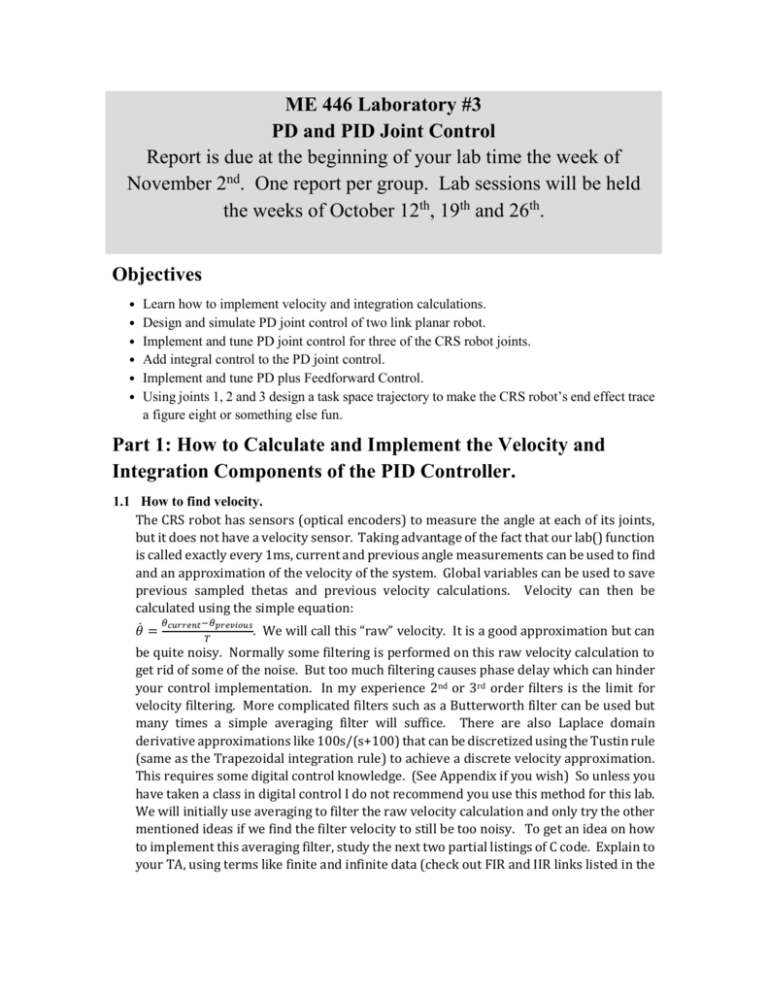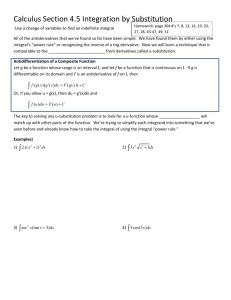Lab 3 (Word Format) - Control Systems Laboratory
advertisement

ME 446 Laboratory #3
PD and PID Joint Control
Report is due at the beginning of your lab time the week of
November 2nd. One report per group. Lab sessions will be held
the weeks of October 12th, 19th and 26th.
Objectives
•
•
•
•
•
•
Learn how to implement velocity and integration calculations.
Design and simulate PD joint control of two link planar robot.
Implement and tune PD joint control for three of the CRS robot joints.
Add integral control to the PD joint control.
Implement and tune PD plus Feedforward Control.
Using joints 1, 2 and 3 design a task space trajectory to make the CRS robot’s end effect trace
a figure eight or something else fun.
Part 1: How to Calculate and Implement the Velocity and
Integration Components of the PID Controller.
1.1 How to find velocity.
The CRS robot has sensors (optical encoders) to measure the angle at each of its joints,
but it does not have a velocity sensor. Taking advantage of the fact that our lab() function
is called exactly every 1ms, current and previous angle measurements can be used to find
and an approximation of the velocity of the system. Global variables can be used to save
previous sampled thetas and previous velocity calculations. Velocity can then be
calculated using the simple equation:
𝜃
−𝜃
𝜃̇ = 𝑐𝑢𝑟𝑟𝑒𝑛𝑡 𝑝𝑟𝑒𝑣𝑖𝑜𝑢𝑠 . We will call this “raw” velocity. It is a good approximation but can
𝑇
be quite noisy. Normally some filtering is performed on this raw velocity calculation to
get rid of some of the noise. But too much filtering causes phase delay which can hinder
your control implementation. In my experience 2nd or 3rd order filters is the limit for
velocity filtering. More complicated filters such as a Butterworth filter can be used but
many times a simple averaging filter will suffice. There are also Laplace domain
derivative approximations like 100s/(s+100) that can be discretized using the Tustin rule
(same as the Trapezoidal integration rule) to achieve a discrete velocity approximation.
This requires some digital control knowledge. (See Appendix if you wish) So unless you
have taken a class in digital control I do not recommend you use this method for this lab.
We will initially use averaging to filter the raw velocity calculation and only try the other
mentioned ideas if we find the filter velocity to still be too noisy. To get an idea on how
to implement this averaging filter, study the next two partial listings of C code. Explain to
your TA, using terms like finite and infinite data (check out FIR and IIR links listed in the
appendix below), what the difference is between these two methods. Which do you think
filters the velocity better? Remember that the Lab() function is called every 1ms.
First Method of Filtering Velocity
float Theta1_old = 0;
float Omega1_raw = 0;
float Omega1_old1 = 0;
float Omega1_old2 = 0;
float Omega1 = 0;
// This function is called every 1 ms
void lab(float thetamotor1,float thetamotor2,float thetamotor3,float *tau1,float *tau2,float
*tau3) {
Omega1_raw = (thetamotor1 - Theta1_old)/0.001;
Omega1 = (Omega1_raw + Omega1_old1 + Omega1_old2)/3.0;
Theta1_old = thetamotor1;
}
//order matters here. Why??
Omega1_old2 = Omega1_old1;
Omega1_old1 = Omega1_raw;
Second Method of Filtering Velocity
float Theta1_old = 0;
float Omega1_old1 = 0;
float Omega1_old2 = 0;
float Omega1 = 0;
// This function is called every 1 ms
void lab(float thetamotor1,float thetamotor2,float thetamotor3,float *tau1,float *tau2,float
*tau3) {
Omega1 = (thetamotor1 - Theta1_old)/0.001;
Omega1 = (Omega1 + Omega1_old1 + Omega1_old2)/3.0;
Theta1_old = thetamotor1;
//order matters here. Why??
Omega1_old2 = Omega1_old1;
Omega1_old1 = Omega1;
}
This infinite average method can be implemented in Simulink with the blocks
1.2 How to implement an integral approximation.
There are a number of different integration rules that can be used to estimate an integral. For
this exercise we will use the trapezoidal approximation to implement the integral portion of
the PID controller. In the PID controller the error signal is integrated. Looking at the below
figure you should be able to see how the trapezoidal rule at each new time step T sums up the
𝑒 +𝑒
new trapezoid sliver of area under the curve giving the equation 𝐼𝐾 = 𝐼𝐾−1 + 𝐾 2 𝐾−1 ∗ 𝑇 to
approximate the integral. The integral normally does not need filtering because its output is
naturally smoother than then its input data.
𝐼𝐾 = 𝐼𝐾−1 +
𝑒𝐾 + 𝑒𝐾−1
∗𝑇
2
Blue
sections eK-1
eK
are IK-1
Orange new
sliver of the
integral
T
T
Approximate
Integral of Error
signal using
Trapezoidal Rule
Part 2: Simulation and PD control of Link two and Link three
of the CRS Robot.
2.1 Dynamic Equations
For this simulation section of the CRS Robot, we are going to focus on just link two and link
three of the CRS robot we used in Lab 1. The equations would get very messy if we included
θ1M. Since we are again working with the CRS Robot, we need to switch back to Lab1’s
coordinate frames. The below simulation model will be given to you but for your report show
that that following derivation is correct. Get out both lab 1 and lab 2 documents. We would
like the equations of motion to return to the coordinate systems of Lab 1. Instead of deriving
the equations of motion using the Lagrange techniques used in lab 2, use the equations found
in lab 2 and just change the coordinates.
Show first, changing from Lab 2’s coordinates to Lab 1’s coordinates, that
𝜃1𝐷𝐻_𝐿𝑎𝑏2 = 𝜃2𝐷𝐻_𝐿𝑎𝑏1 + 𝜋
𝜃2𝐷𝐻_𝐿𝑎𝑏2 = 𝜃3𝐷𝐻_𝐿𝑎𝑏1
and then using the relationship between DH thetas and motor thetas found in Lab 1
𝜃1𝐷𝐻_𝐿𝑎𝑏2 = 𝜃2𝑀 + 𝜋⁄2
𝜃2𝐷𝐻_𝐿𝑎𝑏2 = 𝜃3𝑀 − 𝜃2𝑀 + 𝜋⁄2
Also since 𝜏3𝑀 acts relative to the same base as 𝜏2𝑀 we have the relationship that
𝜏1𝐿𝑎𝑏2 = 𝜏2𝑀 + 𝜏3𝑀
𝜏2𝐿𝑎𝑏2 = 𝜏3𝑀
Substituting these four last equations, along with the derivative and second derivative of
𝜃1𝐷𝐻_𝐿𝑎𝑏2 and 𝜃2𝐷𝐻_𝐿𝑎𝑏2 , into Lab2’s equations of motion, show that the new equations of
motion become.
D( ) C ( ,) g ( )
with
2 M , 2 M , 2 M , M 2
3M
M 3
3M
3M
p1
p3 sin( 3M 2 M )
D( )
,
p2
p3 sin( 3M 2 M )
0
C ( ,)
p3 cos( 3M 2 M ) 2 M
p3 cos( 3M 2 M )3M
,
0
p g sin 2 M
g ( ) 4
p5 g cos 3M
and finally in state space form can be written: (for serial linkages D is always
invertible)
2 M
1
1
1
D( ) D( ) C ( , ) D( ) g ( )
3 M
x1 2 M , x 2 2 M , x3 3 M , x 4 3 M
x1 x 2
x
2
2M
x 3 x 4
x
4
3M
These equations of motion have already be implemented for you in a Simulink starter
file found at http://coecsl.ece.illinois.edu/me446/lab3starter.mdl. You will see that
this Simulink block uses the parameter for the CRS robot arm to be p = [0.0300 0.0128
0.0076 0.0753 0.0298]. These parameters are a best guess using a 3D model of the
robot linkage. The SolidWorks files for this 3D model can be found at
N:\labs\me446\3DModel. Also the M-file used to find these parameters is found at
http://coecsl.ece.illinois.edu/me446/ID_CRS.m.
Given this simulation model, now design and simulate a PD controller that controls
motor 2 and motor 3. The control inputs τ1 and τ2 are computed as
𝑑
𝜏𝑀2 = 𝐾𝑃1 ∗ (𝜃2𝑀
− 𝜃2𝑀 ) − 𝐾𝐷1 𝜃̇2𝑀
𝑑
𝜏𝑀3 = 𝐾𝑃2 ∗ (𝜃3𝑀
− 𝜃3𝑀 ) − 𝐾𝐷2 𝜃̇3𝑀
𝑑
𝑑
Where 𝜃2𝑀
and 𝜃3𝑀
are step inputs from 0 to π/6 radians from t = 0s to t = 1s,
followed by a step back to 0 from t = 1 to t = 2. Since all real motors have limited
torque capability, saturate the torque to +/- 5. Start out with Kp1 and Kp2 equal to 1
and KD1 and KD2 equal to zero. Tune these four gains until you achieve a rise time
less than 300 ms, percent overshoot less than 1% and steady state error minimal.
Produce plots of your step responses along with the torque applied to the system.
𝑑
𝑑
Also produce plots of tracking errors, 𝑒1 = 𝜃2𝑀
− 𝜃2𝑀 ,𝑒2 = 𝜃3𝑀
− 𝜃3𝑀 .
Part 3: PD and PID Control of the CRS Robot.
Part 3.1 Implementation of PD Control on Link One, Two and Three of the CRS
Robot.
Now in Code Composer Studio starting from where you left off in Lab 1, implement
PD control laws for the three joints of the CRS robot. Start with the gains found in
simulation and then tune the gains to achieve Part 2’s design specifications of 300ms
rise time and 1% over shoot. Have the desired reference step back and forth between
0 radians and π/6 for all three joints. Make sure to saturate the torque output
between +/- 5. You should make your three Kp gains and your three Kd gains
accessible to Matlab so they can be tuned while the robot is running. Also collect
response data in an array that Matlab can upload and then plot.
Part 3.2 Add Integral Control.
Now add an integral term to your three PD control loops. Integration is a summing
operator and must be monitored otherwise it could sum up to very large values. This
problem is called integral windup.
You found above that the PD control, once tuned, did a very good job in controlling
the robot’s links. Looking close at your step response plots though, you probably did
see some steady state error. We are going to add integral term to our controller to
attempt to improve this steady state error.
Not only does integration have the problem of integral windup, it also has issues of
creating large overshoots in position control systems. So the way we are going to
implement integral control in this lab is to only turn on the integral term when error
to desired position is small. How small is a tuning parameter.
So add to your PD controllers the integral term KI*IK, where IK is the integral of the
tracking error and calculated using the trapezoidal integration rule. Add this integral
term to your PD control only if the tracking error is less than some thresh hold. And
very important, if the tracking error is greater than the thresh hold make sure to
zero the integral IK and any previous IK-1. To check for integral windup a very simple
way is to just monitor the torque command to the joint’s motor. If the absolute value
of the torque command to the motor is greater than the maximum of 5, then do not
integrate further and leave the integral the value it had the previous sample. Tune
your PID controller’s KP, KD, KI and integral switch point to achieve the desired
response. Create plots of your step responses and tracking error and determine if
integral control improved the system response.
Part 4: PID Plus Feedforward Control.
Part 4.1 Implementation of Feedforward PD Controller.
1. Write a Matlab script file that finds two sets of cubic polynomial coefficients in
order to generate a cubic polynomial trajectory from zero radians to 0.5
radians in one second and the from 0.5 radians to 0 radians in the next one
second. We will use this same trajectory for all three joints of the CRS robot.
This trajectory should therefore satisfy
𝜃 𝑑 (0) = 0 ; 𝜃̇ 𝑑 (0) = 0
𝜃 𝑑 (1) = 0.5 ; 𝜃̇ 𝑑 (1) = 0
𝜃 𝑑 (2) = 0 ; 𝜃̇ 𝑑 (2) = 0
Section 5.5.1 in “Robot Modeling and Control” and section 8.2.1 of “Robot
Dynamics and Control” second edition will help you find these coefficients.
2. Using the coefficients you just found, write a Matlab M-file function that takes
a parameter t seconds. Given t, this function should return
𝜃 𝑑 (𝑡), 𝜃̇ 𝑑 (𝑡), 𝜃̈ 𝑑 (𝑡). If t is greater than 2 seconds, [0,0,0] should be returned.
With this function, generate plots of the desired theta and its first and second
derivatives. Note that you will be writing a similar function in C to generate
the desired trajectory.
3. Implement on the CRS robot a PID plus feedforward control to have the joints
follow the desired cubic polynomial trajectory. See Section 6.4 of “Robot
Modeling and Control” or Section 10.4 for “Robot Dynamics and Control”
second edition. Write a C function, that given t, returns that point along the
polynomial trajectory just like the M-file function you created above. Then
using that trajectory implement the below control law. Ignoring friction,
each joint’s control law will have the form
𝜏 = 𝐽𝜃̈ 𝑑 + 𝐾𝑃 (𝜃 𝑑 − 𝜃) + 𝐾𝐼 ∫(𝜃 𝑑 − 𝜃) + 𝐾𝐷 (𝜃̇ 𝑑 − 𝜃̇ )
Use J1=0.0167, J2 = 0.03 and J3 = 0.0128. This is identical to the controller
you implemented in 3.2 above except that the desired trajectory has been
added. Also note that the sign in front of KD is now positive. Explain why it
makes sense that with step input trajectories as used in sections 2 and 3 the
KD term is appropriate to be −𝐾𝐷 𝜃̇ but now that we are generating
polynomial trajectories the derivative term is +𝐾𝐷 (𝜃̇ 𝑑 − 𝜃̇). Also remember
to implement the integral in the same fashion as before only applying
integral control when the error is small and zeroing the integral when error
is large. Because we are using polynomial trajectories the error should
remain small as the joint moves along the trajectory. For this reason integral
control will be active more of the time and may need some retuning along
with the “small” error threshold for the integral. The KP and KD gains may
also have to be returned to meet specifications.
Part 5: Follow a repeating trajectory.
5.1 Follow a trajectory of your choice.
For this exercise come up with new trajectories for each joint that make the
CRS robot arm repeatedly follow a fun trajectory. One idea would be to code
your inverse kinematic equations that given an x,y,z point in space returns
the three motor angles. With this code you could have the robot follow a
straight line or a figure 8. As a safety check first code your trajectory
equations in a Matlab M-file and with plots make sure the trajectory never
takes the robot arm outside of its angle limits. Then code the same trajectory
in C and see how well the robot can follow your trajectory.
Report: (Minimal Requirements)
1.
2.
3.
4.
5.
6.
Include your Simulink simulations
Include the final version of your C code that followings desired trajectories.
Include any Matlab M-files you created
Answer the questions found in the lab.
Explain how you generated your last “fun” trajectory.
Did you notice any performance differences between the different control methods?
Appendix
1. Tustin Rule
2. FIR filter
3. IIR filter
https://en.wikipedia.org/wiki/Bilinear_transform
https://en.wikipedia.org/wiki/Finite_impulse_response
https://en.wikipedia.org/wiki/infinite_impulse_response






